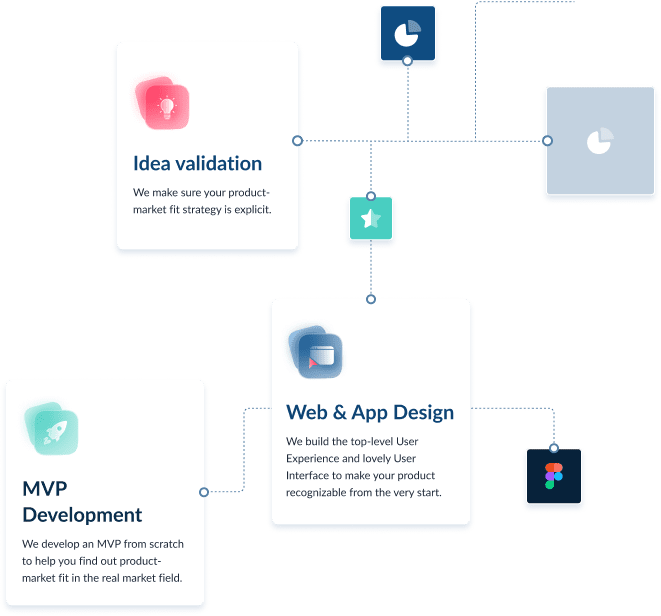7 Effective Tips to Scale from an MVP to a Full-Scale Product
- Updated: Nov 13, 2024
- 10 min
Validating a business model with a minimum viable product (MVP) is one of the most popular startup launch strategies. Why?
Launching with an MVP allows you to validate your business model and ensure it is profitable and valuable before investing in a full-fledged product.
In this article, we’ll discuss:
- The key differences between a minimum viable product and a full-scale product
- 7 practical tips to refine your MVP and scale it into a finished product ready for market
Whether you’ve already launched an MVP or are in the planning stages, you’ll learn actionable steps to iterate on feedback, expand features, bolster infrastructure, and implement robust testing.
Looking to streamline the development process? Here are some helpful app development tips to guide you.
Let’s dive in!
Transform your MVP into a market-ready product with our expert software developers — contact us today to get started!
What’s the Difference Between Minimum Viable Products and Full-Scale Products
Coined by Frank Robinson and popularized by Eric Ries, an MVP or “minimum viable product” isn’t a technology prototype, but a way to validate its sale.
Startups build MVPs to:
- Test their business ideas
- See how their target markets respond to product demo versions
- Apply product refinement feedback to improve value development
For instance, instead of testing your actual mobile app prototype, you might benefit from our MVP development services to test a connected landing page with a “Buy Now” call to action (CTA) button.
Or you might use it to test your app prototype’s customer support options.
Still, some startups may refer to an MVP as:
- A stripped-down version of a product
- A product on its way to success
- An initial version of a product in need of customer feedback
A full-scale product, on the other hand, is the complete and final version of a product. It includes all intended features, functionalities, and specifications for its final market release.
In other words, it’s a product and a game plan that’s ready for mass production and widespread use.
After you’ve tested your business hypotheses and selected the most viable option, you can begin scaling your idea into a complete and feature-rich product. 
You can also make sure all related sales systems and marketing campaigns are prepped and ready to convert potential customers into loyal fans.
Try our CPM calculator to measure ad efficiency based on cost per thousand impressions.
7 Ways of Scaling from an MVP to a Full-Scale Product
With that said, let’s review seven ways you can transition your MVP into a full-scale product.
1. Refining Your Product Based on User Feedback
Measure customer satisfaction by gathering feedback from users and analyzing the results. Use the insights you uncover to improve your product as best as possible.
Be sure to ask active users:
- What design elements they’d like you to change
- What essential features or details are missing
- How intuitive the design feels
- What specific problems the product is helping them with and how it could solve their pain points even better
- What (if any) user experience issues they’ve had
- If they’ve experienced any bugs, lagging, or glitches when using the app
- If they’ve used a similar app that solved their problems better than your app does — if so, how and why?
- How likely they are to invest in and continue using your product
- How likely they are to recommend your product to someone they know
After you’ve applied the insights you’ve gathered so far, don’t stop! Continue collecting and applying ongoing customer feedback, even after the official product launch.
For instance, Clean Origin stands out as a prime illustration of a company that caters to its customers indefinitely.
Through its innovative approach, Clean Origin empowers customers to choose every facet of their diamond order — from shape to cut to carat and color.
This interactive experience engages visitors and allows them to personalize their journeys.
As its customers’ carefully selected diamonds transform into exquisite engagement rings, Clean Origin’s commitment to quality and customization shines through. How?
Clean Origin’s interactive approach not only captivates customers but also strategically gathers recurrent feedback to improve its operational efficiency.
The brand facilitates ongoing feedback and operational improvement with:
Real-Time Customization
Clean Origin’s customization options allow customers to actively engage with their product design.
This empowers customers to express their preferences and desires, providing immediate feedback on their unique choices.
Data Collection
Throughout the customization process, Clean Origin collects valuable data on customer preferences and user behavior.
It analyzes which specific diamond shapes, cuts, colors, and other options are most popular. This helps the brand continue to tailor its offerings to match customer trends and demands.
Startups often overlook branding — but a strong strategy can set you apart. Here’s how to develop a brand strategy.

Personalization Insights
By understanding customer preferences, Clean Origin gains insights into the type of engagement rings that resonate with its audience.
This data informs its future designs and product offerings, resulting in more refined and captivating products.
Whether you’re a startup or a seasoned pro, this guide on MVP design will save you time and money.
2. Enhancing the User Experience
Pay close attention to improving your product’s user interface and design. Make it visually appealing and user-friendly to create a positive first impression.
Be sure to also streamline your app’s navigation and functionality by simplifying menus, buttons, and processes so users can easily find what they need.
You’ll also need to optimize your product’s loading speed and performance. Enhance the backend infrastructure to make sure your product runs smoothly and efficiently.
And speaking of infrastructure …
From concept to creation – launch your marketplace with SPDLoad!
3. Scaling Infrastructure to Meet User Demand
In digital product development, scaling up your infrastructure is pivotal to handling increased user demand.
But doing so without auditing your current setup can lead to unnecessary system crashes and inevitable UX issues.
That’s why it’s crucial to assess your current infrastructure and identify potential bottlenecks.
Then, work closely with your developer to upgrade servers, databases, and other necessary components.
You’ll also need to implement appropriate scalability measures to accommodate increased user demand.
For instance, you can:
- Employ cloud infrastructure: Leverage cloud-based services to scale up your app’s resources as needed, providing seamless performance even during peak times. This article on the cloud migration discovery phase outlines the key steps for a successful migration.
- Opt for horizontal scaling: Instead of relying solely on vertical scaling (upgrading hardware), consider distributing the workload across multiple servers to handle increased traffic effectively.
- Implement caching strategies: Use caching techniques to store frequently accessed data, reducing the load on your app’s backend and improving response times.
By applying these scalability measures, you can make sure your app is ready to handle increased user demand without compromising performance. Not sure what any of this means? Let us handle it all for you!
4. Expanding Your Feature Set
At this point, you’ve created a basic version of your product, refined it, and scaled your infrastructure.
Now, it’s time to turn your bare-bones app into a high-value product with key features your audience craves.
Here’s how:
Conduct market research and analyze competitor offerings
Understand your target audience and the market landscape to identify gaps and potential opportunities for new features.
Identify new features and functionalities aligned with user needs and preferences
Continue gathering feedback from your users, conducting surveys, and analyzing user behavior to uncover what they truly want.
Prioritize and implement features based on their potential impact
Evaluate the feasibility and impact of each feature idea, considering factors like user demand, development resources, and potential business value.
By following these steps, you can enhance your app’s offerings and better serve your users’ needs.
Get inspired by Jasper.ai, a well-funded AI writing tool designed to generate marketing copy.
The company raised $125 million in October of 2022 to expand its feature set.
Its business objective?
Launching enterprise-grade generative AI features for its Jasper for Business suite. 
This included:
- Jasper Everywhere to extend Jasper’s generative AI to run wherever users are working — including in content management systems and online docs
- Jasper Brand Voice to help enterprises customize content creation to match their brands’ style and tone
- An API (application programming interface) to help enterprise teams extend generative AI to their own application development
But possibly the best move Jasper has made concerning its new enterprise features is paying close attention to hyper-personalization.
Its Jasper for Business tools combines multiple generative AI models for ultra customization, according to its president, Shane Orlich.
“Think of Jasper as this application layer that’s sitting on top of many different models, including our own models. We’re able to pick and choose which pieces of those models we want to support in order to create the right piece of output for our customers.”
5. Pre-Launch Testing and Quality Assurance
Manual software and QA testing is crucial to identifying and fixing any bugs, glitches, or usability issues before your app goes live.
Testing not only promotes a smooth user experience but can also help minimize negative reviews and customer churn.
Churn rate calculator is a useful tool for SaaS businesses aiming to maintain a stable customer base.
Some best practices for testing and quality assurance include:
- Developing a testing plan: Outline the scope, objectives, and test cases you’ll execute during all stages of development.
- Conducting functional testing: Verify that all features work as intended and make sure your product has seamless functionality across different devices and operating systems.
- Performing final usability testing: Get final feedback from real users to evaluate your app’s UX and make improvements based on their insights.
- Testing security and performance: Validate your app’s security measures and assess its performance under different traffic loads.
- Performing regression testing: Re-test previously validated features to make sure that new code changes or updates didn’t introduce any additional bugs or issues.
For instance, Nlyte, a trailblazing company in data center management, serves as an exemplary model for transforming an MVP into a globally recognized solution.
Its commitment to QA testing and frequent updates shines through in its success.
What began as a need to find better ways to manage the complexity of data center resources, evolved into a comprehensive suite of tools.
Nlyte has been empowering organizations to optimize their data center operations efficiently ever since.
By pioneering DCIM solutions, Nlyte helps organizations manage their computer infrastructure across various environments — from sustainable data centers to colocation, managed services, edge, and IoT.
Through constant updates and a sharp understanding of its customers’ needs, Nlyte exceeds the demands of industry giants. This includes Google, Cisco, IBM, and 40+ Federal Agencies, like NASA. 
With an impressive customer retention rate of 98%, Nltye’s growth is a testament to the importance of testing, customer-centricity, and continuous improvement.
Сhurn rate calculator is a useful tool for SaaS businesses aiming to maintain a stable customer base.
6. Investing in Robust Security
Protecting your app’s security is crucial to building trust with your users and safeguarding valuable information.
To protect your investment and your customers, identify vulnerabilities and potential risks in your app’s infrastructure, code, and data storage systems.
Be sure to conduct this security audit thoroughly and often to continue providing the best user experience.
You’ll also need to implement security protocols and measures. These may include using:
- Encryption
- Secure authentication
- Access controls
Be sure to also regularly track and update your security systems. Stay proactive by monitoring for any suspicious activity, applying security patches, and keeping up with cybersecurity best practices.
For extensive support, reach out to a cybersecurity expert who specializes in app security.
7. Developing a Marketing Plan
You’ve got a great new product to show off, but you need sales systems and marketing campaigns to help you get the word out.
To develop your strategy, start by outlining your target audience and creating buyer personas.
In your personas, explain who your ideal customers are, their demographics, and what needs and pain points they have.
You’ll also need to list how your product meets their needs and solves their problems better than the competition. Use your personas to tailor every aspect of your marketing efforts.
If you are looking for ways to elevate your email strategy, our email marketing for startups tips are here to help you communicate effectively with your audience.
Next, develop a strong brand identity and message. Clearly define your brand’s values, personality, and unique competitive advantage in your messaging.
For instance, “We help remote companies automate employee time tracking and payroll in multiple currencies. Our product saves remote teams 30+ hours per month on mundane HR tasks.”
By the way, if you are looking for HR software development inspiration, check out these best HR software solutions on the market. 
Then use targeted marketing channels to reach and engage potential customers.
Choose platforms, such as social media, email marketing, content marketing, and SEO to reach your target audience where they spend their time online. To improve your email marketing game, check out these 7 easy and effective email template strategies to generate more leads.
Finally, set up sales funnels to automate lead generation and conversions.
Establish a step-by-step process that guides potential customers from awareness to conversion, using tools like landing pages, email sequences, and remarketing campaigns.
Meet with a marketing team that specializes in helping SaaS companies if you need support setting these up.
If you’re deciding between software models, this comparison of the ASP model vs SaaS model can help you choose.
Crafting Custom Mobile Apps That Delight Users!
Key Takeaways
Launching with a minimum viable product and scaling to a full-fledged offering is the most cost-effective, low-risk approach to validate your business idea and attract early adopters.
By starting small and iterating based on user feedback, you can:
- Confirm product-market fit and pivot if needed
- Start marketing and gaining traction sooner. Check out how to set marketing objectives correctly to reach your audience.
- Focus funds on optimizing user experience
- Mitigate common software development risks
When planning business strategy and customer outreach, CLTV calculator gives companies a way to see the long-term revenue potential of their customer base, making it easier to plan ahead.
As you consider the next steps, we’re here to help guide the process – whether assisting with MVP creation, testing capabilities, or feature scoping.
Let’s connect in a free consultation to explore how we can help turn your MVP into a full-fledged product users love.
If you’re entering the SaaS world, these best SaaS startup ideas are worth exploring.













